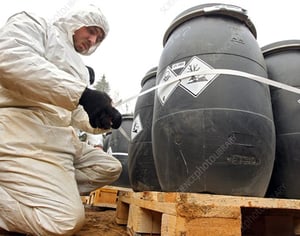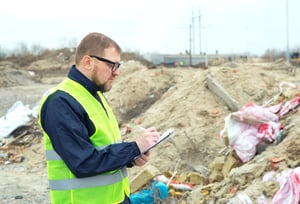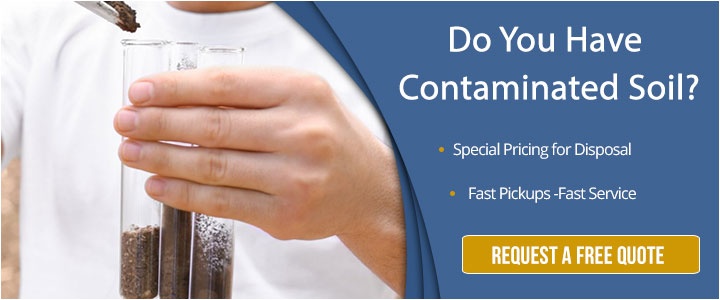The earth beneath our feet is a precious resource that sustains all life on this planet. But when it becomes contaminated with harmful substances, it can turn into a ticking time bomb that threatens human health and the environment.
From toxic chemicals to heavy metals, contaminated soil can pose a serious risk to communities. If your business has unearthed soil contamination in the midst of a construction project, it may feel as though you suddenly have a crisis on your hands.
The truth is, contaminated soil is quite common. Instances that can unearth or create soil contamination include:
- Construction activities, like digging foundations, building roads or installing pipelines
- Redeveloping land that was previously used for industrial or commercial purposes
- Environmental cleanup after a spill or leak of hazardous materials
- Agricultural practices, such as the use of pesticides and fertilizers that leach into soil on adjacent properties
- Landfill issues, including improperly contained waste contaminating nearby soil
- Mining activities that can lead to pollution through the use of chemicals and heavy metals in the extraction process
However, how you deal with this environmental (and business) issue can determine whether it becomes a manageable situation that can be effectively resolved or a long-term problem that in the end will be costly for your business.
Let’s take a closer look at how to clean up contaminated soil and why your plan should consider all the stages of removal, including disposal.
Approaches To Cleaning Up Contaminated Soil
When soil pollution is discovered, there are various approaches that can be taken to clean it up. The right method will depend on a range of factors, including the type and extent of the contamination, the location of the contaminated area and the intended use of the land.
will depend on a range of factors, including the type and extent of the contamination, the location of the contaminated area and the intended use of the land.
Some methods may involve removing and disposing of the contaminated soil, while others may focus on treating the soil in place. It’s important to choose an approach that is both effective and sustainable, as well as compliant with any relevant regulations and guidelines.
The basic approaches to cleaning contaminated soil include:
- Containment
- Bio-remediation
- Chemical oxidation
- Soil washing
- Thermal treatment
Containment
Soil containment involves containing the soil in one spot so that any contaminants do not spread. Heavy-duty liners are placed under and around any contaminated soil to prevent the migration of contaminants into soil or groundwater. These liners must be periodically checked for damage as well.
A landfill cap then serves as a barrier layer that prevents toxic effects to nearby areas. A cap can be made of varying materials depending on how the soil has been contaminated. For example, the cap could be constructed using a layering system of vegetated soil and the use of plants or asphalt concrete.
Bioremediation
Bioremediation uses organic materials to initiate biological processes in the soil that eventually will remove contaminants. Micro-organisms such as bacteria and fungi are used in this process because they use the contaminant as a food source.
Bioremediation is often used when mitigating pollutants like halogenated organic solvents and compounds, as well as hydrocarbons, nitrogen compounds, some metals and non-chlorinated pesticides and herbicides. While this soil remediation process is natural and sustainable and is preferred as a way to avoid using chemicals, it can take several months to fully carry out.
Chemical Oxidation
During the chemical oxidation process, a compound is injected into the area of soil contamination. The primary responsibility of this reactive chemical oxidant is to destroy the contaminants.
This solution is sought after when soil contamination occurs at deep levels below a structure and can be used to treat a variety or organic contaminants like TPH (total petroleum hydrocarbons), BTEX (benzene, toluene, ethylbenzene and xylene) and PCBs (persistent organic pollutants).
Reactive chemical oxidants can also be added to groundwater, permeating through the soil. When rapid contamination control is warranted, such as during a leak, this chemical process is a great option for fast remediation.
Soil Washing
Soil washing physically separates soil from its contaminants. During the washing approach, a solution comprised of cleaning fluid and water passes through a contaminated soil sample. Contaminants are more likely to bind to fine-grained soil and silt, and soil washing effectively removes these fine-grained pieces from the larger soil sample.
However, it is important to note that the contaminant is not destroyed. It’s moved to a new location.
Thermal Treatment
The thermal treatment method moves contaminants in soil using heat. During this heating process, some contaminants are destroyed. Others move through soil toward another place, such as wells, where crews collect them and pipe them to the ground surface.
Also known as “in situ,” the heat is applied underground directly to the original area of contamination. This method is used when contaminates include solvents, petroleum and wood preservative creosote because they do not dissolve easily in groundwater.
There are a few different main methods in which this heat can be applied, including by delivering an electrical current underground, injecting steam underground that is pumped through wells drilled in the area contaminated and using heaters placed in underground steel pipes.
How Contaminated Soil Is Removed
What happens once the clean-up process is completed depends on which process was used to handle the contaminated soil.
contaminated soil.
As we showed above, there are several different methods to cleaning up contaminated soil. Some include keeping the soil in place and treating it through processes like bioremediation. Other methods involve disposing of the the contaminated soil.
It’s important for site managers and facility owners to keep in mind that many landfills will not accept certain types of soil unless testing shows that the contaminants fall below the maximum allowed levels. For some contaminants, these may be very small amounts.
Some landfills may set their own maximum allowed levels, and other times, only certain landfills may accept lead contamination in soil or other types of contaminants. You may even be faced with the prospect of having to transport your soil out of state in order to dispose of it properly or to find a facility that will perform the needed treatments that remove the contaminants before the soil can be disposed of at a landfill.
That’s where experienced hazardous waste disposal companies come in. It’s critical to work with a reputable disposal company that has developed connections with landfills throughout California and across the United States to ensure your soil disposal process goes smoothly and according to the law.
Remember, contaminated soil is just that - contaminated. It’s considered a hazardous waste and must transported by a vendor licensed to carry contaminated substances.
Contaminated soil disposal companies typically use specialized equipment and vehicles, such as dump trucks or roll-off trucks, that are designed to contain and transport the contaminated soil safely. Workers will load the soil onto the trucks using heavy machinery, including excavators or loaders, and then cover the soil with a tarp or other type of containment material to prevent any soil from falling or blowing out during transport.
Workers will then drive the trucks to the designated disposal facility. Once the contaminated soil is unloaded at the disposal site, it is treated or disposed of according to the specific regulations and procedures in place.
The Best Disposal Companies Will …
Determine What Contaminates You’re Dealing With
Make sure any disposal company you choose offers hazardous substance determination through sampling and profiling. Although you may be familiar with the contaminants you are removing and disposing of, you need to be aware of quantities since many landfills will only accept a certain amount of a specific chemical or contaminant.
profiling. Although you may be familiar with the contaminants you are removing and disposing of, you need to be aware of quantities since many landfills will only accept a certain amount of a specific chemical or contaminant.
There are many different soil contaminates that can seep into the ground, including:
- Inorganics, such as lead, chromium, arsenic, mercury, leaded gasoline, lead-based paint and other materials from manufacturing processes
- Semi-volatile organics, such as polychlorinated biphenyls (PCBs), polynuclear aromatic hydrocarbons (PAHs), dioxins/furans, pesticides, capacitors, transformers and other materials from agricultural processes
- Volatile organic compounds, such as solvents, benzene, degreasing agents and substances used at dry cleaners or in the chemical and plastics manufacturing industry
- Fuels, including gasoline, diesel, jet fuels, waste oils or fuels from underground storage tanks and refineries
Land can become contaminated in any number of ways, from manufacturing runoff to storage tank leaks, spill accidents and improper runoff processes.
If the amount of contaminants you have in your soil is low, you may not even need hazardous waste removal. A quality company can help you determine this so that you don’t pay for a service you do not need.
Develop A Customized Plan For You
Before contaminated soil cleanup work begins, a disposal company should develop a customized soil transportation plan for the project. This plan should include completing any regulatory paperwork and offering proof that your contaminated soil has been properly disposed of so you have proof for your records.
The best disposal companies will also offer expert services as part of your emergency plan in case you experience hazardous materials incidents, and you need immediate action in extreme cases.
Offer A Walk-Through Program
An extension of developing a customized plan for your company includes offering a walk-through program. A walk-through program is consultative in nature and can help you plan for any potential issues you may face (and how to solve these challenges) before a job even begins.
Be Experienced … And Have The Proof To Show It
The disposal company you work with should have a valid hazardous waste transporter registration with the Department of Toxic Substances Control (DTSC).
While experience in soil contamination is important, it’s also a good idea to work with a well-versatile disposal company in other relevant areas, such as industrial waste or even non-hazardous waste. Check in with other companies that have used the disposal service you are considering to better gauge what kind of experiences they had working with the company.
Never Use A Middle-Man
As a final note, the best disposal companies will avoid working with hazardous waste brokers. These types of brokers are unqualified “middlemen” who drive up your costs and create roadblocks by putting themselves in between you and certified hazardous waste disposal companies under the disguise of helping you.
They often show up in Google paid ads, leading you to believe they are professionals and providing you with legitimate information. Instead, they will add on as much as 400% of the disposal cost an actual disposal company would charge. Most importantly, you lose control over which disposal company will handle your hazardous waste.
Instead, it’s important for you to work with transporters directly so you can ensure that any hazardous waste is handled properly and so you have an opportunity to establish a positive relationship with the company. In the long run, this will result in a more efficient and cost-effective hazardous waste solution for your business.


Comment